Recent Articles
The Point: a Franco-American Heritage Site in Salem, Massachusetts
Traditional French Songs in Ontario
Fort William, Crossroad of a Fur Trading Empire
The Guigues Elementary School in Ottawa
Centre franco-ontarien de folklore (CFOF)
Centre de recherche en civilisation canadienne-française (CRCCF)
Articles
-
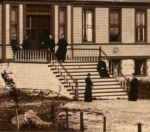
Baie-Ste-Marie (Nova Scotia) Eudists
In 1890, the Eudists [Congregation of Jesus and Mary] arrived from France to set up an educational institution for Nova Scotian Acadians of Baie Sainte-Marie [St. Mary's Bay]. They also took charge of two parishes in the region. Over the decades that followed (mainly until the 1970s), members of the Congregation would fill the roles of educator, religious community builder, administrator, writer, and even nationalist. Their presence at Point-de-l'Église [Church Point] is an example of a cross-cultural encounter between the French and Acadian communities that left its mark on the region on architectural, cultural, and religious levels. The gradual transition from being a congregation consisting mostly of French priests to one staffed almost entirely with Canadian clergy created a balance between these two cultural factions within the institution. Over the years, the Eudist contribution to the Nova Scotian French-speaking community's heritage has been expressed in a wide variety of ways.
-

Catherine de Saint-Augustin, Remembered from Quebec to Normandy
Beatified by Pope Jean-Paul II in 1989, Catherine de Saint-Augustin is considered to be one of the founders of the Canadian Roman Catholic church. Born in Saint-Sauveur-le-Vicomte (Normandy, France) in 1632, Catherine de Longpré joined the ranks of the hospital order in Bayeux in 1644. A short time later she volunteered to assist the nuns operating the Quebec City Hôtel-Dieu hospital, and so, in 1648, she set foot in New France for the first time. In the land of her adoption, she led an exemplary life and died there of an illness at a very young age in 1668. Her growing renown in the Province of Quebec in the 19th century for her good works eventually opened the way for her to be venerated in her homeland of France.
-
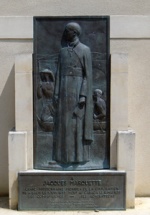
Father Marquette Monument in Laon: Commemorating an North American Historical Figure on French soil
Born in Laon, Northern France, in 1637, the Jesuit priest Jacques Marquette discovered the Mississippi River in 1673, as he explored the region alongside Louis Jolliet, the Quebec-born noble, merchant and explorer. Father Marquette died near the present-day city of Ludington, Michigan, in 1675. When his bones were discovered in 1877, he became a renowned historical figure in the United States, but remained largely unrecognized in France. The story of the monument built in 1937 in Marquette's hometown to honour this North American historical figure illustrates just how whimsical the local memory of him could be. A Jesuit long-disowned in France due to anticlericalism, Father Marquette was honoured in his home country when his historical contributions as an explorer and mapmaker were finally recognised.
-
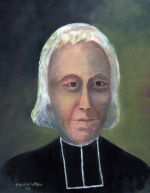
Father Sigogne and Nova Scotia’s Acadian Heritage
Jean-Mandé Sigogne, born in France on April 6th, 1763, was ordained a parish priest in 1787. He went into exile in England five years later to escape the French Revolution and in 1799, he agreed to travel to Acadia (present-day Nova Scotia). There he founded the parishes of Cap-Sable and Baie Sainte-Marie, which were composed of destitute Acadians who had reassembled after the Deportation (1755-1763). In his 45 years in the region, he helped build nine churches, founded schools and secured major land grants for the Acadian people. Father Jean-Mandé Sigogne died on November 9th, 1844, after exerting a profound and lasting influence on the region. He lives on in the memory of Nova Scotian Acadians through his writings, the region's heritage buildings and a number of monuments erected in his honour.
-

Marie de l’Incarnation Memorial Sites in Tours
Marie Guyard, better known as Marie de l’Incarnation, was born in Tours, France. She lived there forty years, from birth in 1599 until she left for Canada in 1639. She is one of the pioneers of New France, where she founded the Ursuline convent at Quebec City, the first school for Indian and French girls in North America. She lived in this convent until her death in 1672. While she is well known in Quebec, her memory was almost forgotten in her native land, where only a handful of devotees, scholars and city councillors remembered this modest provincial woman of the seventeenth century, who left for Canada’s “few acres of snow”. However, since the 1950s, thanks to the tireless efforts of a group made up of Canadians and Tourangeaux, supported by a few elected officials aware of the influence of the French language in North America, the memory of Marie Guyard is finally receiving the attention it deserves in Tours.
-
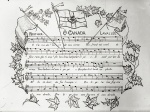
O Canada: From French Canadian Patriotic Song to National Anthem
Every country has a national anthem, and Canada—with its O Canada—is no exception. National anthems are symbols meant to bring people together, crystallizing their sense of belonging and collective identity. Played or sung at official ceremonies and on solemn occasions, they are supposed to encapsulate what is best in a country or nation. That, in theory, is their purpose. But the destiny of an anthem may change over time to reflect transformations in a country or nation. Such is the surprising story of O Canada. A French Canadian patriotic song before becoming Canada’s national anthem, it is a fixture at sporting events like professional hockey games and the Olympics, yet opinion is still divided on its importance as a symbol of identity. Today, the role of this 19th century song remains the subject of debate and reconsideration.
-

Reclaiming French Heritage at Fort St. Joseph in Niles, Michigan
Fort St. Joseph was one of the most important eighteenth-century frontier outposts in the western Great Lakes region. Initially established by the French as a mission in the 1680s, the site became a hub of religious, military, and commercial activity for local Native American populations and European colonial powers for nearly a century. While late nineteenth-century collectors knew the location of the site, it became forgotten until its rediscovery in 1998 by Western Michigan University archaeologists. Subsequent investigations and public involvement have resurrected the community’s interest in its French heritage.
-
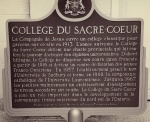
Sacred Heart College, Sudbury
An Ontario Heritage Trust plaque at the corner of Notre-Dame and Kathleen streets in Sudbury marks the location of Sacred Heart College. Thousands of students passed through the college doors over the years, with many going on to become leaders who left their mark on the Franco-Ontarian community and beyond. The English plaque reads as follows: “The Society of Jesus opened a classical college at this site in 1913. The next year the province granted Sacred Heart College a charter giving it degree-granting powers. At first the college was bilingual, but after 1916 it taught exclusively in French. Sacred Heart College became a centre for the education and formation of young Franco-Ontarian men. In 1957, it changed its name to the University of Sudbury, which became the Catholic component of Laurentian University in 1960.” Sacred Heart College played a crucial role in the flowering of French Ontario’s collective identity and memory. It was here that Société historique du Nouvel-Ontario (SHNO) was founded in 1942. Today, this important heritage organization keeps local history alive with its archival collection, conferences and publications.
-
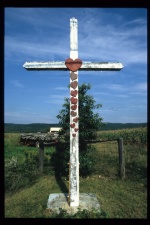
Wayside Crosses
Nearly3,000 wayside crosses are still standing along the highways and byways of theProvince of Quebec. They representa precious heritage-a legacy of the past. The first crosses were erected by Jacques Cartier as a symbol ofterritorial appropriation. Later,the pioneers used them to mark the founding of a village and French Canadianpeasant farmers (then known as habitants) did thesame upon staking their land claims. All sorts of reasons have led French Canadians to put up waysidecrosses: farmers set them up closeto their fields for divine protection; parish priests erected them to indicatethe site of a future church; parishioners raised them up on the halfway pointalong a concession or range road, where they would gather for the eveningprayer. Although wayside crossesare first and foremost religious objects, over time they have taken on a moreheritage-oriented significance, their distinctive outline characterising aparticularity of the Quebec countryside that has come to be associated with thefaith of the French Canadian forefathers.
Images
-

Missionnaire_je__suit
e.gifArticle :
Coverdale Collection -

1st row, L to R: Fath
er Edmond Pratt... -

Paul Le Jeune, missio
nnaire jésuite ... -

Charles-Agapit Beaudr
y, prêtre-colo...Article :
The French Language in Manitoba: French-Canadian and European Roots
-

En 1819, lord Selkirk
, qui a acquis ... -

La première cloche ap
portée par les ... -

Missionnaire jésuite
au XVIIe siècle... -

Fort Saint-Joseph – m
issionnaire jés...Article :
Reclaiming French Heritage at Fort St. Joseph in Niles, Michigan
-

Carte de la Nouvelle-
France, 1657Article :
Sainte-Marie-among-the-Hurons: a little-known gem of “Ontario’s New France” -

Murale de la cabane à
sucre des Père...
Documents PDF
-
Liste des missionnaires jésuites du Canada passés par La Flèche, 1610-1760
Taille: 73 Kb
Article :
Royal College La Flèche, Wellspring of Missionary Zeal

